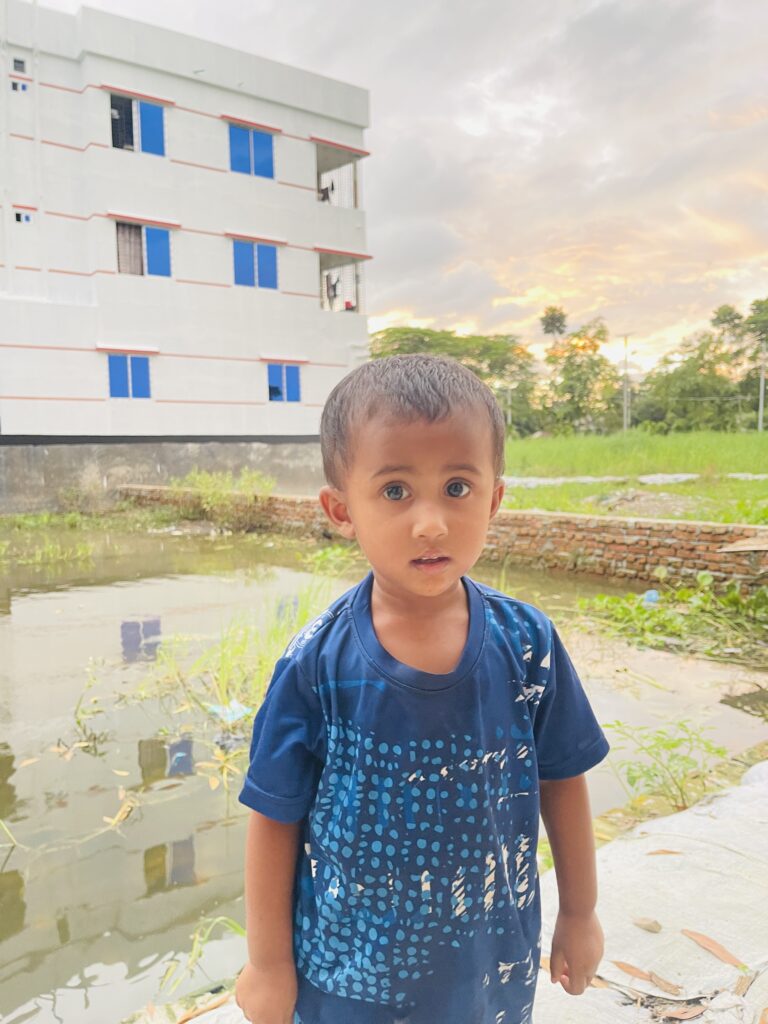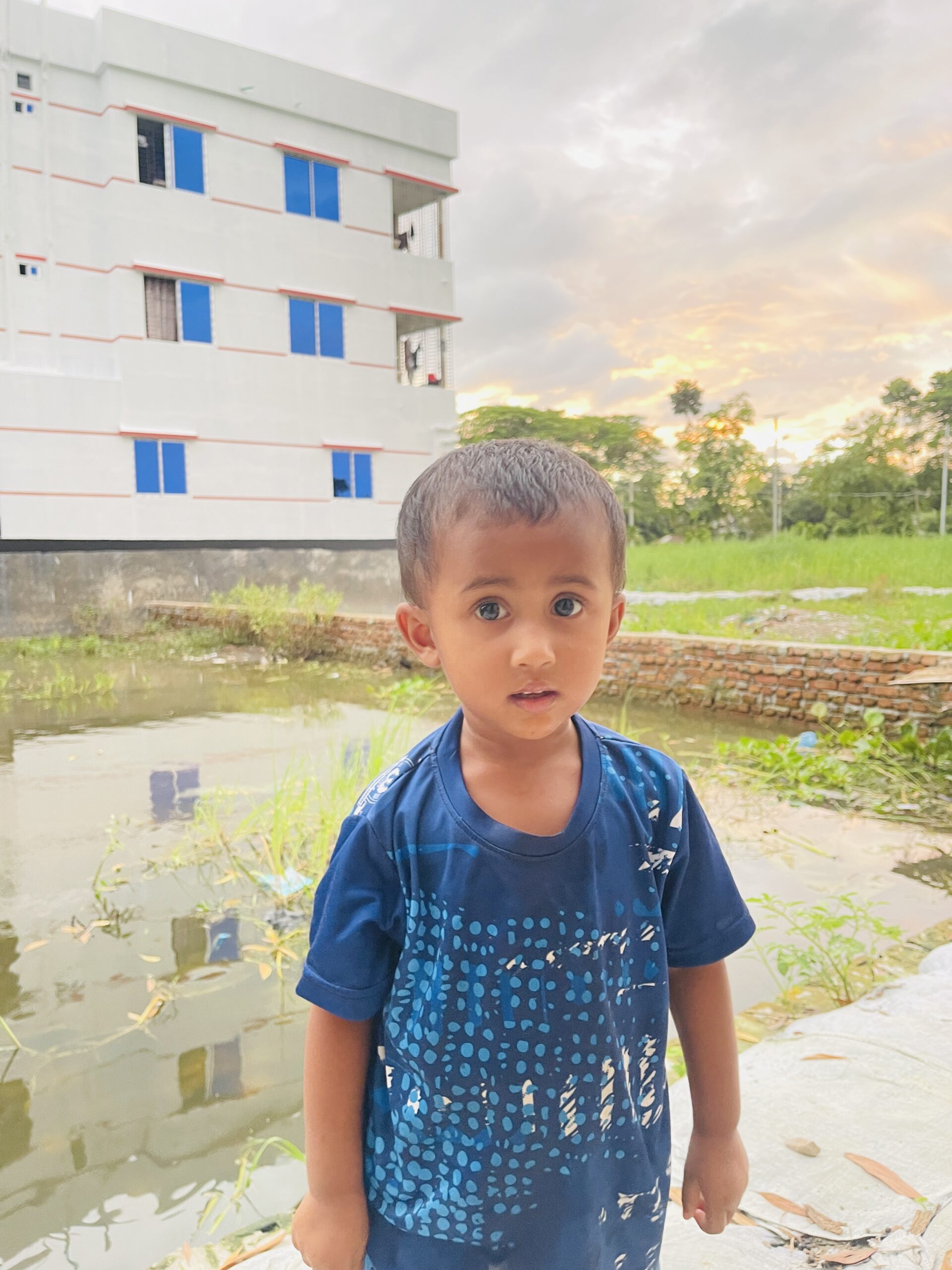How Save Earth Society is Advocating for Forgotten Children Like Eva in Bangladesh’s Garment Hubs

In the heart of the Unaishar slum in Cumilla, Bangladesh, a two-year-old girl named Eva plays barefoot in the mud. She has no shoes, no toys, and barely enough clothes to cover her. Her eyes are wide with curiosity, but her world is confined to a cramped alley outside a tin shack. Her mother, Morzina, is a garment factory worker who leaves at dawn and returns late at night—just to afford a handful of rice and a roof of plastic and rust.
Eva has no father. No one to watch her. No future—unless someone chooses to care.
Yet despite the hardship, her mother dreams aloud:
“My daughter will be a lawyer one day. She will speak for those who are never heard.”- Eva Mother
It’s a vision that seems far-fetched in the context of abject poverty. But it is not impossible—not if organizations like Save Earth Society continue stepping in where systems fail.
The Hidden Face of the Garment Sector: Forgotten Children
Bangladesh’s Ready-Made Garment (RMG) industry employs over 4 million people, 80% of whom are women (ILO, 2022). While their labor powers an industry that brings in $45 billion a year, their children often live in extreme deprivation—left in slums, informal daycare, or alone in hazardous spaces.
Slum children like Eva are exposed to:
- Malnutrition
- Unsupervised danger
- Early disease and abuse
- Zero access to early education
According to UNICEF (2023), over 1.1 million children in Bangladesh’s urban slums live without proper care or basic rights. Most do not attend preschool, and nearly half suffer from stunting due to poor nutrition.
Save Earth Society: Beyond Environment—For People, Too
While known for environmental projects like tree planting and plastic waste reduction, Save Earth Society also runs social support programmes for families at the intersection of poverty, gender inequality, and climate vulnerability.
Its work includes:
- Providing emergency clothing and nutritional aid
- Establishing informal schooling and daycare corners in slums
- Advocacy for child protection, especially for abandoned or working-class children
The organization believes that planet protection cannot be separated from people protection. Founder Md Mahamudul Hasan emphasizes,
“We cannot speak of saving the earth while children sleep hungry and play in filth. The future of the planet lives in children like Eva.”- Mahamudul Hasan
Eva’s Day Without a Bed

Eva wakes up on a shared floor mat with three other families. There’s no crib, no safety rail, no running water. She eats when she’s fed—often rice, lentils, or sometimes nothing. With her mother at work and no community daycare, she spends the day wandering barefoot in alleys or playing in sewage-laced soil.
She is only two years old, but the conditions she faces pose real and lasting risks. Studies by the World Health Organization (WHO, 2021) show that slum exposure to unclean environments in early childhood leads to lifelong respiratory issues, weakened immunity, and reduced cognitive development.
Small Steps, Big Change: What Can Be Done
Save Earth Society is now campaigning to adopt Eva’s care under its “Children First” initiative, which provides:
- Monthly nutrition packs
- Clean clothes, shoes, and hygiene kits
- Access to community-run early learning support
- Emotional care via trained community volunteers
The plan includes enrolling Eva in a preschool bridge program that prepares underprivileged children for formal schooling by age six. The society is also exploring ways to support Morzina with flexible work or sewing projects she can manage from home.
“We need more than sympathy,” says project lead Anika Tasmirat. “We need systems of care that support working mothers and protect their children.”
Long-Term Investment: From Play to Power
Child-focused investment is not charity—it’s nation-building. Research by Save the Children (2022) shows that each dollar spent on early childhood care yields a return of $6–$17 in improved health, education, and productivity outcomes over a lifetime.
Eva, now just a barefoot child in a Cumilla slum, could grow into a lawyer, activist, or community leader—if only she is seen, supported, and given a fair start.
Policy & Partnerships: What the Nation Must Do
Bangladesh has progressive frameworks like the Child Act (2013) and National Children Policy (2011). However, implementation in slums remains woefully inadequate, especially for:
- Unregistered children
- Informal workers’ dependents
- Migrant and unaccompanied minors
Save Earth Society recommends:
- Public-Private Partnerships for slum daycare and learning centers
- Micro-support grants for working mothers like Morzina
- Urban housing reform with safe child spaces
- Community-led child tracking to ensure early nutrition and enrollment
Voices from the Ground
Eva’s neighbour, Rokeya, adds:
“Eva plays with broken plastic. She should be playing with books.”
One volunteer from Save Earth Society notes:
“We don’t need miracles. We need people to see these children—not as burdens, but as potential.”
Eva is Every Child
Eva’s story is not just hers. It is shared by millions of children growing up in poverty, caught in cycles of invisibility. Yet, if even one child is helped, the chain begins to break.
Save Earth Society is asking citizens, donors, and policymakers to step in—not with pity, but with partnership. To give Eva more than food—to give her a chance.
Because sometimes, a lawyer doesn’t begin in a classroom. She begins barefoot in a slum, with a dream in her mother’s voice.
“My daughter will speak for those who are never heard.”
Let’s make sure she gets that chance.
References
International Labour Organization. (2022). Women in Bangladesh's RMG Sector. Retrieved from https://www.ilo.org
Save the Children. (2022). Early Childhood Investment in South Asia. https://www.savethechildren.net
UNICEF. (2023). State of Children in Urban Bangladesh. Retrieved from https://www.unicef.org/bangladesh
World Health Organization. (2021). Child Health and Environment – Urban Slums. Retrieved from https://www.who.int
Government of Bangladesh. (2011 & 2013). National Children Policy and Children Act. Bangladesh Gazette.

